
verhoevenc
-
Posts
2,963 -
Joined
-
Last visited
-
Days Won
28
Content Type
Profiles
News and Information
Tutorials
Product Reviews
Supplier Listings
Articles
Guitar Of The Month
Links and Resources
Forums
Gallery
Downloads
Posts posted by verhoevenc
-
-
I used titebond. It was the bamboo ply product from eco supply.
Side note: the extra piece that was left over and hung out in my barn unfinished molded up FAST. Weird material... likely won’t use it again.
Best,
Chris
-
 1
1
-
-
- Popular Post
This guitar requires dues to be paid. I was highly intrigued by the aesthetic of Tao guitars' T-bucket instruments. I liked both the square, inlaid pickguard idea as well as their flare for not only juxtaposing color, but also textures, in their instruments. This was really fun to do here with the high-gloss blue stabilized buckeye burl inlaid "pickguard" square, contrasted with the muted, satin pewter finish elsewhere. I also wanted to test myself to see if I could create an instrument with Mustang-style switching but without the back cover plate that would have hindered my ability to have a robust belly carve. Can you figure out how I was able to get all those switches and pickups in there without a back cover plate?
True to form for the mixture of Jaguar and Mustang elements on this build, it features a short 24" scale length. Many people have not played with these types of instrument,s but they are a great deal of fun. After building my first shortscale (a blue paisley offset) I just had to make another when that one left for it's new home.
Neck-- Wood: Flamed roasted maple
- Fretboard: East-Indian rosewood
- Scale: 24"
- Radius: 9.5"
- Nut Width: 1 11/16"
- Carve: Thin C
- Headstock: Straight string pull 3-a-side in pewter with flamed roasted maple wings
- Inlays: Blue stabilized buckeye burl dots with aluminum outlines
- Tuners: Hipshot open-back locking
Body-
- Wood: Poplar
- "Pickguard": Blue stabilized buckeye burl
- Width: 13.5"
- Bridge: Fender adjustable mustang bridge and jazzmaster tremolo
- Finish: Satin, real pewter coat body, high-gloss lacquer "pickguard" square, and tru-oil neck
Electronics- This guitar features 2 claw-less Jaguar pickups configured like a traditional "Mustang." The slide switches allow each pickup to be turned on/off and placed in or out of phase with one-another.
Hope you like,
Chris
-
 6
6
-
Here is a completed 'stage acoustic' (read: 2" thick, fully hollowed out body, with true acoustic top) that I did for a local company. Company colors, theme, logo, etc. Working with the celluloid pearl was a first, and definitely not a last as I've come to really like the material.
Specs: Engelmann spruce top, sapele body and neck, rocklite Ebano fretboard and bridge. 25.4" scale, 16" radius fretboard. K&K piezo pickup. More details here: Gallery and Details

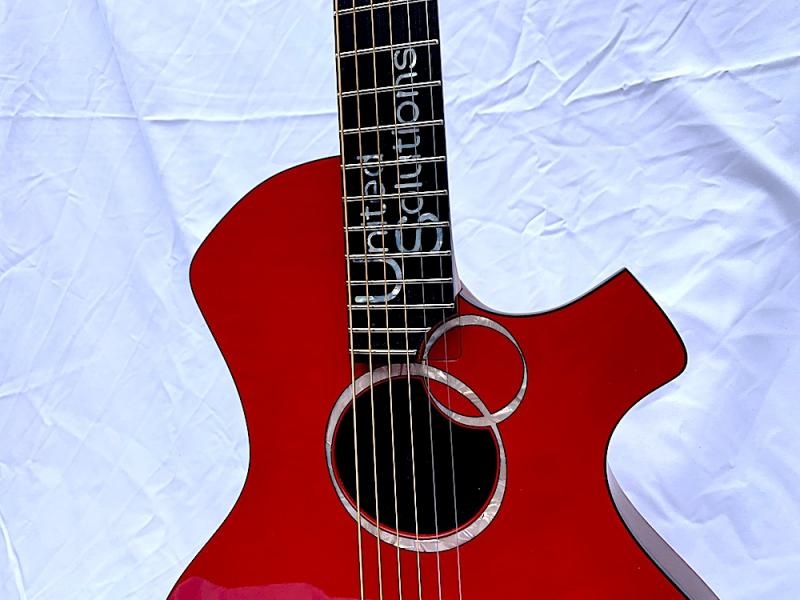


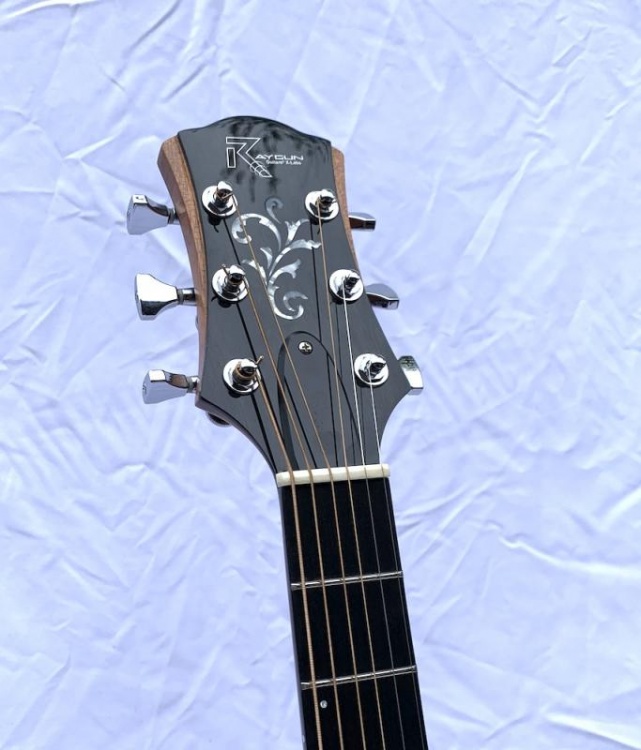
This was a fun project that has sparked a LOT of new ideas in my head. When I saw just how loud it turned out, it told me just how powerful a thin-bodied acoustic concept can be... and just how fun that platform can be to mess with. Hopefully get some personal-project time soon to continue playing with these ideas.
Best,
Chris
-
 4
4
-
-
I'm 100% with Crusader. Frustrating as all hell. I think that part I like best is lumber processing... which isn't really guitar building anyways hahahaha.
But for some reason I keep doing it.
Chris
-
 2
2
-
-
I just bought a "portable" greenhouse off Amazon to spray in. Yeah it was $80, but it's awesome. Goes together easy, take it apart for the future. Super handy as a ghetto spray booth to avoid particles in the wind (a must if ever doing a solid color IMO).
Chris
-
 1
1
-
-
I can do this. However, with out CAD files to match your EXACT inlays... I wouldn't guarantee the work at all. The reason is, inlays, especially in maple, you are working to tolerances of a few thousandths of an inch. So yes, this isn't a complicated shape, but without knowing the exact dimensions of your particular pyramid inlays... who knows if the routes will actually fit them, be too loose, etc.
You'll need a matching DXF or DWG (or other CAD file) to match your inlays to have this done right. Where did you get the inlays? They may be able to help with more info.
Chris
-
 1
1
-
-
That bridge angle looks HUGE. Does it intonate?
Chris
-
 1
1
-
-
What kind of neck/blank? Is it already thicknessed for a bolt-on? Or is it a big block that you could plane down a bit and still have what you need left?
Chris
-
Didn't read through, so apologies if any of this has already been said but:
- Wood glues are always your go to for wood-on-wood joints... but there are many types of wood glues!
- Wood glues will be more forgiving to mistakes. If you find a gap in your work after the glue has hardened, you can reheat, press in, re-clamp, and fix the issue. This will not be the case with CA. Given wood binding is sometimes more tricky than plastic at getting the shape JUST RIGHT, I'd say this is a plus!
-
Fish glue (a wood glue) will have amazingly larger open time than, say, titebond. It is my #1 glue of choice for wood binding. It is amazing stuff. HIGH (read ridiculous) initial tack, slow dye time so long open time, and really long shelf life (so it doesn't matter if you ONLY use it for binding).
- Don't believe that BS about fish glue having a one-year shelf life. Go find some old stuff and test it... it's still fantastic.
My $0.02,
Chris
-
 1
1
-
Maybe it's the tinting of the pic and lighting... but that looks like padauk to me. Description sounds like it too.
Is it bright orange? Sawdust bright orange and get on everything?
Chris
-
Wow... TOTALLY out there but also 100% works! Way to push the boundaries.
Chris
-
Indeed I am a real boy! And have all my digits! hahaha
Chris
-
 1
1
-
-
I still have some of the Myka jigs available. There's a thread in the sales section if you search.
Chris
-
Looks super tight. Not sure I'd have put the bottoms so close to the frets, but that's preference, note execution!
Chris
-
 1
1
-
-
What in the world happened to all these posts?
Chris
-
I wish I could remember who bought this so I could see what ever came of it!
Chris
-
I have done this on several actual bodies now and it works like a charm! But yes, with my CNC.
I've done something SIMILAR without CNC though. I took my template and a 1/2" rabbit bit and made a smaller template. Then used a 1/4" bit following this smaller template to route a channel 1/4"" in from the edge to inlay some cool purfling into. That said, this only worked because I was fairly far inside the body... I'd be skeptical of my skill being able to do this with templates and come out with the body cut exactly on the binding perfectly. Problem is in close spaces the human eye is capable of pickup up on discrepancies of .010"... so unless you get the .060" binding EXACTING, the eye will notice.
Chris
-
 1
1
-
 1
1
-
-
I have sprayed nitro over tru-oil just fine. I can't say for "other oils." But generally, the longer it's been on there, the better.
Chris -
- Popular Post
This archtop is very dear to me as it is not only for a dear friend of mine but it was also a super-fun platform to innovate on since I had control over most of the specs. Essentially I had to use black and white ebony, amboyna burl, and it had to be an acoustic archtop in my Model1 shape. Other than that the rest was up to me! So I played with some fun things like:
- A bolt-on version of my compound-bend all-access neck joint
- Radial purfling using burl
- Carbon fiber (neck, neck block buttresses, and laminated in pickguard)
- 3D printed structural elements (can't really see them though)
- Charlie Christian pickup
- Completely hollowed ebony bridge
- Oval hole and fan bracing
- Back-strapped diamond volute
Here she is relaxing in her new home:
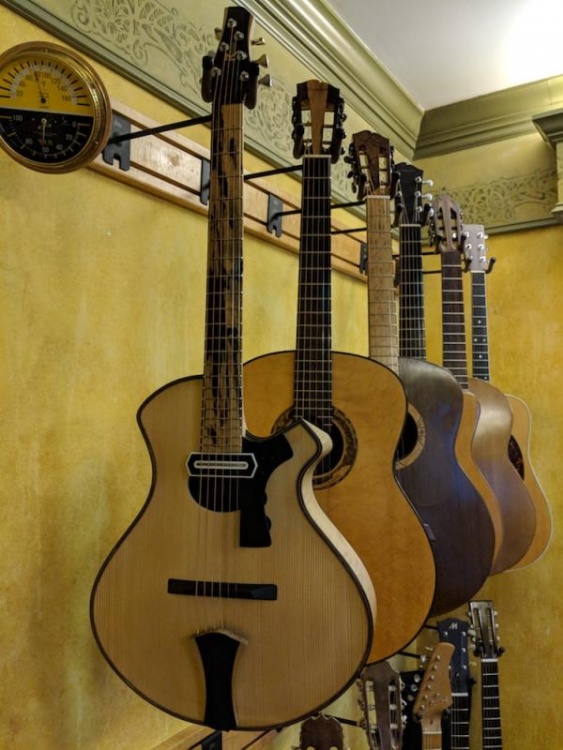
The specs are: Curly maple neck, back & sides. Note: the back is domed like a flat-top not carved. Carved sitka spruce top with ebony binding and tons of crazy multi-layer purfling. Black & white ebony fretboard and tailpiece (veneered in normal ebony expect the "wings"). Hollow ebony bridge and CF-laminate ebony floating pickguard. Buffalo bone nut and saddle. 25" scale board with 12" radius and 1 3/4" nut. Finish is odie's oil neck with satin nitro headplate. Body is all done in an tru-oil with some additional wizardry to keep it from soaking deep into the top and potentially hurting the acoustic resonance.
One thing I want to point out that doesn't matter for the final product, but I'm still proud of: I decided to fully hand gramil all the binding and purfling channels on this box. What a process... won't do it again... but glad I did it once so I can truly appreciate binding jigs and bearing bits!
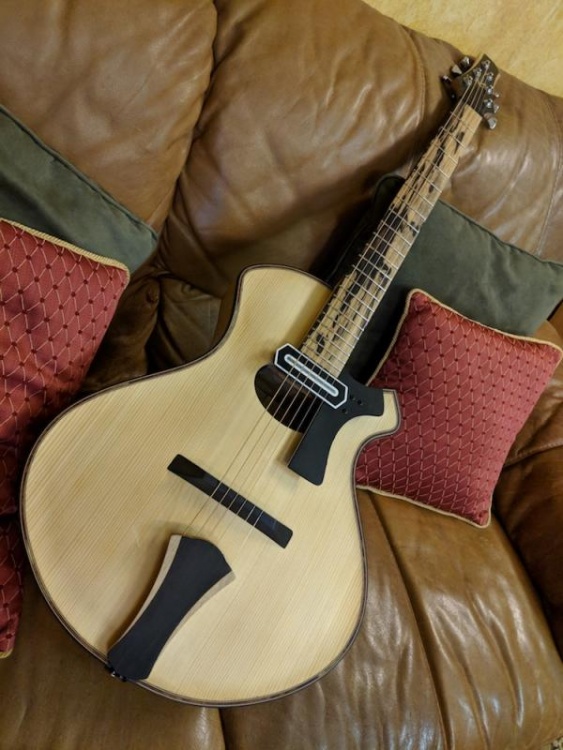



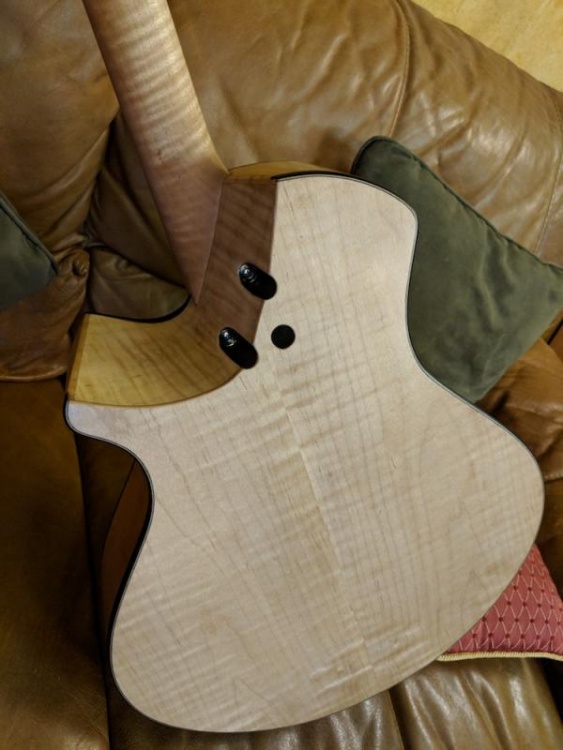
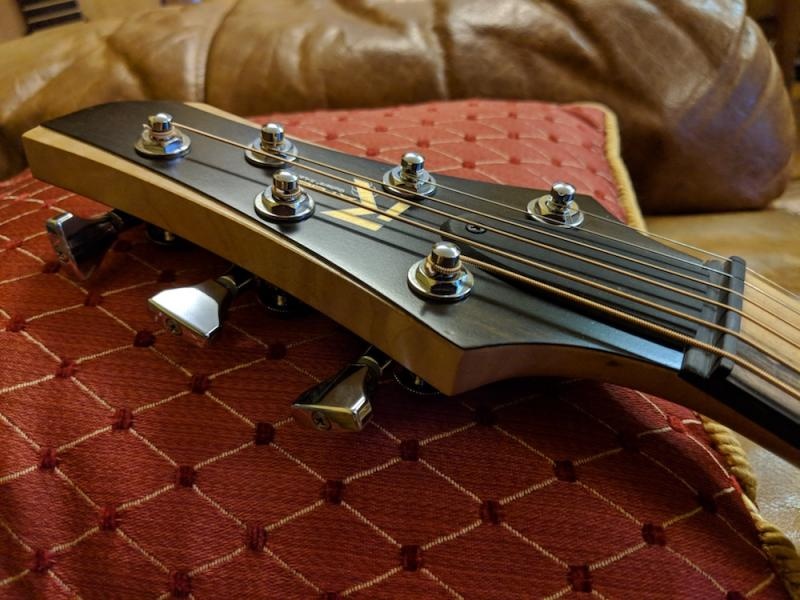
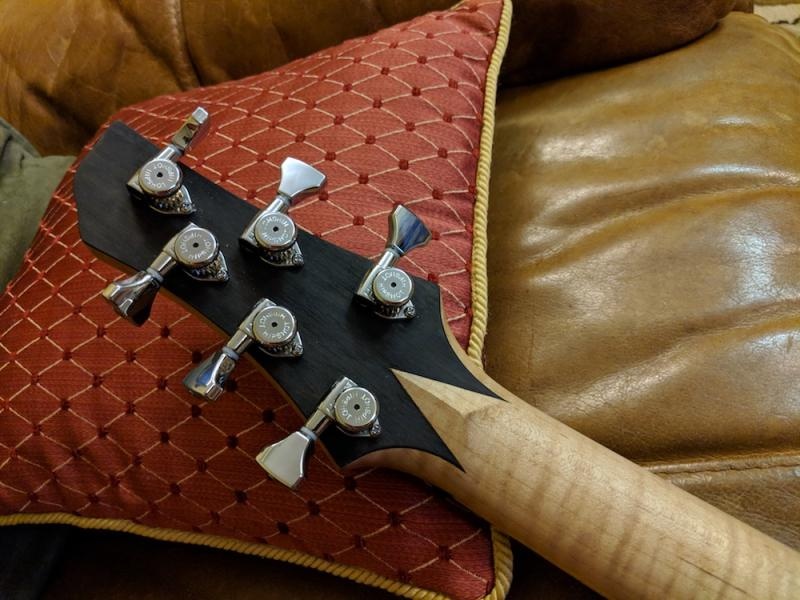
If you'd like to learn a (lot) more about this project, it's history, why the specs are what they are then feel free to waste 30 minutes here:
Best,
Chris
-
 6
6
-
I also think you need more contrasting color... the blue is overpowering right now. Think about black for you pickguard (still bound in white) and headstock (I'd bind that to match too) IMO. Too much of a good thing is still too much; and I think blue is a good thing.
Chris
-
 1
1
-
-
DeltraLectro but please don't make that fretboard blue hahaha.
Chris
-
 1
1
-
-
I wouldn't say that. Most guys using this are making MUCH smaller pieces... they buy toaster ovens that you attach a temp regulator to, etc. When you go big you start getting into much weirder territory. Sort of like the difference between baking a cupcake vs. a turkey. Turkey's gunna have a lot more considerations to get it right. You'll need bigger "tools" for the turkey too.
Also, most of the info out there is on the smaller stuff... but this has all been learn by doing (failing) for the guitar-sized pieces.
There are other companies with similar products, but the general rules apply to all of them.
Chris
-
 1
1
-
-
Sadly you can't use the heat-wood-then-use-resin trick on these stabilizing resins. They have one property that kind of ruins this: if they get over 80 degrees and do not continue up past 185 for 10 minutes to cure... then they'll never cure! I've seen pics of guys that didn't know a heat wave was coming in and left their stuff running out in the garage only to come back to a permanently gel-form of resin because it broke the 80 degree threshold but never went through the full cure cycle at >185. With that in mind I have to actually be very careful not to put even warm wood into the resin. This is why I have the giant ziplock bags to let the wood cool in (and not pick up moisture) after the drying or curing stages, before they go back into resin.
As for the info on how heat works in a thicker piece I'll have to read up more about this!
Best,
Chris
-
Acrylic bodies have been used for decades. BC Rich did it, Dan Armstrong did it, etc. The latter seeems to be good enough for Dave Grohl to use and many collectors to flock to... so it's probably fine lol.
There's a company around lately that's been taking burl slabs and filling out the extra area needed with resin. They're pretty cool but for that life of my I can't remember their name. Either way, yes, resin and/or resin/wood hybrids are totally fine for use in guitars. I'd personally just caution about how MUCH of the guitar is made from that for one simple reason: resin will be heavier than most woods used for guitar bodies.
My $0.02,
Chris
























FREE NOW: Myka Style Neck Pocket Jigs- Minimal Assembly Required
in The Marketplace
Posted
I’m moving. I still have a few of these.
You can have them FOR FREE but you have to pick them up (I’m way too busy to ship things now).
I’m in the DC suburbs of Maryland. PM me if you’re interested. They get trashed mid-September.